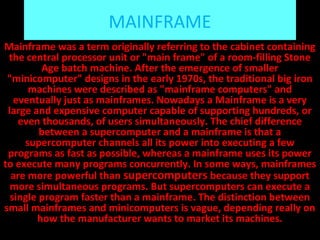basics of the computer system part -1
- 2. Defining computers A computer is an electronic device that: •Accepts information and instructions from a user •Processes data •Stores data for later retrieval •Produces out put
- 3. TYPES OF COMPUTER 1. PERSONAL COMPUTER 2. MAINFRAME COMPUTER 3. MINICOMPUTER 4.SUPER COMPUTER
- 4. PERSONAL COMPUTER: It can be defined as a small, relatively inexpensive computer designed for an individual user. In price, personal computers range anywhere from a few hundred pounds to over five thousand pounds. All are based on the microprocessor technology that enables manufacturers to put an entire CPU on one chip. Businesses use personal computers for word processing, accounting, desktop publishing, and for running spreadsheet and database management applications. At home, the most popular use for personal computers is for playing games and recently for surfing the Internet.
- 5. MAINFRAME Mainframe was a term originally referring to the cabinet containing the central processor unit or "main frame" of a room-filling Stone Age batch machine. After the emergence of smaller "minicomputer" designs in the early 1970s, the traditional big iron machines were described as "mainframe computers" and eventually just as mainframes. Nowadays a Mainframe is a very large and expensive computer capable of supporting hundreds, or even thousands, of users simultaneously. The chief difference between a supercomputer and a mainframe is that a supercomputer channels all its power into executing a few programs as fast as possible, whereas a mainframe uses its power to execute many programs concurrently. In some ways, mainframes are more powerful than supercomputers because they support more simultaneous programs. But supercomputers can execute a single program faster than a mainframe. The distinction between small mainframes and minicomputers is vague, depending really on how the manufacturer wants to market its machines.
- 6. MINICOMPUTER It is a midsize computer. In the past decade, the distinction between large minicomputers and small mainframes has blurred, however, as has the distinction between small minicomputers and workstations. But in general, a minicomputer is a multiprocessing system capable of supporting from up to 200 users simultaneously.
- 7. SUPERCOMPUTER Supercomputer is a broad term for one of the fastest computers currently available. Supercomputers are very expensive and are employed for specialized applications that require immense amounts of mathematical calculations (number crunching). For example, weather forecasting requires a supercomputer. Other uses of supercomputers scientific simulations, (animated) graphics, fluid dynamic calculations, nuclear energy research, electronic design, and analysis of geological data (e.g. in petrochemical prospecting). Perhaps the best known supercomputer manufacturer is Cray Research.
- 8. PARTS OF THE COMPUTER SYSTEM A complete computer system consists of mainly four parts. 1.hardware( the computer) 2.Software(programs) 3.Data( information) 4.User (people)
- 9. HARDWARE Hardware is a comprehensive term for all of the physical parts of a computer, as distinguished from the data it contains or operates on, and the software that provides instructions for the hardware to acoomplish tasks. The boundary between hardware and software is slightly blurry - firmware is software that is "built-in" to the hardware, but such firmware is usually the province of computer programmers and computer engineers in any case and not an issue that computer users need to concern themselves with.
- 10. SOFTWARE Software is a generic term for organized collections of computer data and instructions, often broken into two major categories: system software that provides the basic non- task-specific functions of the computer, and application software which is used by users to accomplish specific tasks.
- 11. INPUT DEVICE An input device is any hardware device that sends data to a computer, allowing you to interact with and control it. The picture shows a Logitech trackball mouse, which is an example of an input device.
- 12. OUT PUT DEVICES EXAMPLES SPEAKER,HEADPHONES,LCD PRINTER, LCD, MONITOR
- 14. output device An output device is any device used to send data from a computer to another device or user. Most computer data output that is meant for humans is in the form of audio or video. Thus, most output devices used by humans are in these categories. Examples include monitors, projectors, speakers, headphones and printers.
- 15. Parts of a mouse















